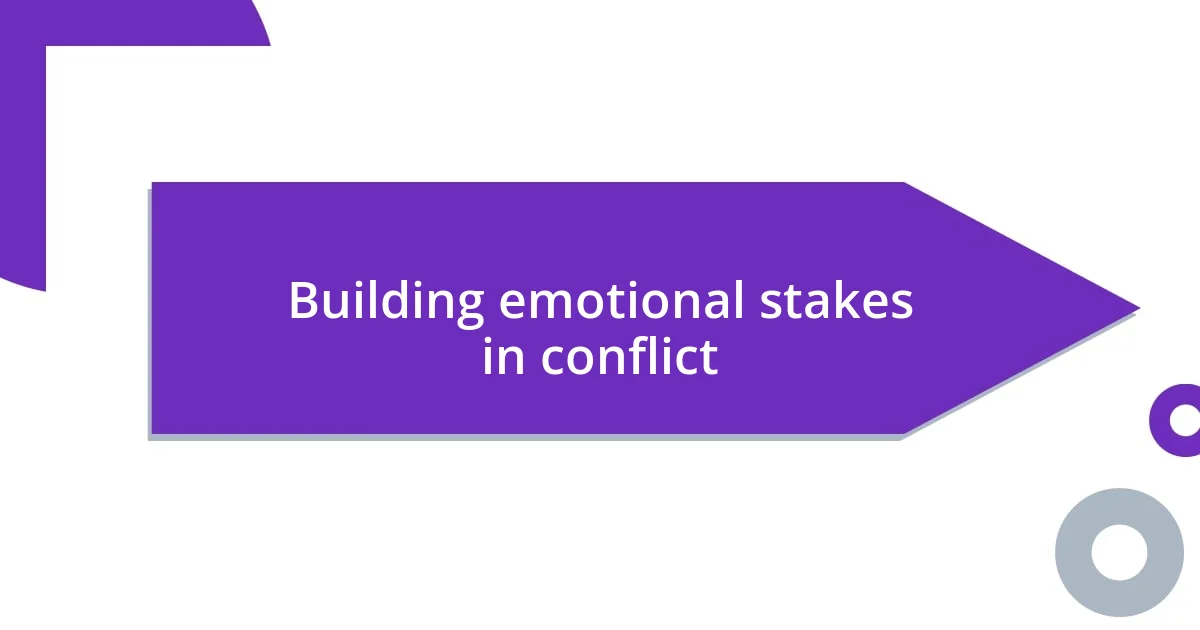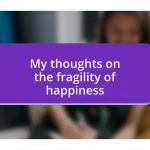Key takeaways:
- Character conflict is essential for storytelling, revealing deep motivations and emotional stakes that resonate with readers.
- Types of conflict, including internal, interpersonal, societal, and situational, add depth and tension, engaging audiences through relatable characters and evolving goals.
- Effective dialogue and meaningful resolutions enhance emotional impact, allowing characters to grow and connecting their experiences to the readers’ own lives.

Understanding character conflict
Character conflict is the heartbeat of a compelling story. I remember grappling with two characters in my own writing who simply couldn’t see eye to eye; their opposing desires created not just tension but a deeper exploration of their motivations. Have you ever felt that clash within your own relationships?
When characters collide, it often reveals their deepest fears and desires. For instance, I once wrote about a character striving for freedom while another clung to tradition. The emotional weight of their battle illuminated the complexities of human existence—don’t we often find ourselves torn between what we want and what is expected of us?
Understanding character conflict goes beyond mere disagreements; it’s about the stakes involved. A few years ago, I penned a story where one character’s secret could destroy a friendship. The fear of betrayal heightened the tension and made the resolution all the more impactful. Isn’t it fascinating how the choices we make—sometimes based on conflict—can define our relationships and ourselves?

Types of character conflict
Character conflict can take various forms, each bringing unique tension and depth to the narrative. When I think about conflict, I often reflect on my own experience with friends who had differing values. This polarization can create narratives that resonate on a profound emotional level. Here’s a breakdown of some key types of character conflicts:
-
Internal Conflict: This arises when a character grapples with their own decisions or feelings. I once wrote about a character battling guilt over a choice to betray a close friend. The inner turmoil provided an emotional core to the story.
-
Interpersonal Conflict: This occurs between characters with opposing goals or desires. For instance, in one story, a protagonist faced off against an antagonist driven by revenge, which made every interaction electric with tension.
-
Societal Conflict: Here, characters clash with societal norms or expectations. I remember exploring this concept through a character fighting against their family’s pressure to follow a predetermined career path; it mirrored my own struggles with expectations from loved ones.
-
Situational Conflict: This type arises from circumstances that pit characters against one another. I experienced this firsthand in a narrative about survival, where two characters must contend with dwindling resources and their differing strategies.
By understanding these types of conflicts, I’ve found they serve as pivotal tools in crafting stories that resonate deeply with readers, revealing truths about our own lives along the way.

Creating relatable character goals
Creating relatable character goals is essential for driving conflict and keeping readers invested. I recall creating a character whose dream was to become a musician, but her family dismissed her passion in favor of a stable career. This discrepancy not only heightened the conflict with her family but also resonated with anyone who has faced pressure to conform. When we establish goals that reflect real-life dilemmas, it deepens the connection between characters and readers.
Setting relatable goals also involves ensuring that these aspirations evolve throughout the narrative. In one of my stories, a character started off wanting wealth and success but realized as conflicts arose that happiness stemmed from meaningful relationships instead. This journey of self-discovery not only propelled the plot but also allowed readers to reflect on their definitions of success. How often do we pursue goals that don’t truly fulfill us?
Lastly, I’ve learned that including setbacks or obstacles is crucial. A character seeking a promotion could face a rival colleague who is vying for the same position, creating palpable tension. I experienced a similar situation in my own career, where competition led me to re-evaluate my strategies. It’s through these struggles that characters become relatable, prompting readers to cheer them on as they navigate their personal journeys.
| Character Goal | Related Conflict |
|---|---|
| Desiring independence | Clash with family expectations |
| Pursuing passion | Facing societal norms |
| Seeking success | Rivalry in the workplace |

Building emotional stakes in conflict
Building emotional stakes in conflict is all about making the reader feel what’s at risk for the characters involved. I remember a scene I crafted where a mother had to choose between saving her estranged daughter or her long-held dream of starting a business. The weight of that decision created an emotional anchor for the story, inviting readers to empathize and consider what they might sacrifice for family. Have you ever felt torn between ambition and love? It’s a poignant struggle that resonates deeply.
I’ve found that the best way to deepen emotional stakes is by exploring characters’ backstories and relationships. For instance, in a recent narrative, I introduced a character whose fear of failure stemmed from a parent’s harsh criticism. This fear not only drove her actions but also set the stage for a heartbreaking conflict with a well-meaning mentor. When readers sense the emotional history, it amplifies the tension—suddenly it’s not just about the moment, but about everything it represents. Don’t you think knowing what drives a person often makes conflicts more riveting?
Moreover, I emphasize the importance of clear stakes. In another story, I had a character risking everything to protect a secret that could destroy her community if revealed. This heightened tension because not only was her personal happiness at stake, but the well-being of those around her. When characters have much to lose, the emotional stakes skyrocket, creating a gripping narrative. Isn’t it fascinating how our choices often have broader repercussions than we initially recognize?

Escalating tension through dialogue
Dialogue can be a powerful tool for escalating tension in a story. I remember writing a heated conversation between two friends who had differing views on a significant event. As they spoke, their words clashed like swords, revealing deeper issues and unresolved feelings that had simmered beneath the surface. It was that raw exchange that made readers feel the heat of their conflict, drawing them further into the narrative. How often do we find that our most honest discussions reveal more than we intend?
In crafting dialogue, I’ve discovered that the rhythm and brevity can significantly enhance tension. Short, snappy exchanges can create an atmosphere charged with emotion. For example, I once created a scene where a character’s refusal to answer a direct question spoke volumes, leaving the other character frustrated and on edge. That pause before a response can be deafening, and it’s those moments of silence that often resonate most clearly with readers. Isn’t it intriguing how what is unsaid can sometimes carry more weight than words?
I also find that contrasting dialogue styles can amplify conflict. In one of my narratives, I juxtaposed a character who was calm and reasoned against another who was impulsive and angry. Their contrasting approaches didn’t just heighten the tension; it showed competing motivations and perspectives, inviting readers to pick sides. Have you ever noticed how different speaking styles can create an electric atmosphere? It’s a reminder that dialogue is not just about what is said, but how it is delivered and received.

Resolving conflict for impact
When it comes to resolving conflict, it’s crucial to strike a balance that maximizes emotional impact. I recall a scene where two siblings, long estranged over a family dispute, found themselves unexpectedly facing a shared crisis. The resolution came not from a grand gesture, but through a simple, heartfelt conversation. This moment didn’t just resolve their conflict; it reflected their growth and demonstrated the power of vulnerability. Have you ever felt that a small gesture can shift the entire trajectory of a relationship?
In writing, I often lean towards resolutions that offer redemption or deeper understanding. For instance, in one story, a character recognized that his anger was rooted in grief. Instead of a hasty apology, he took time to reflect before finally bridging the gap with honesty and heartfelt dialogue. This not only resolved the conflict but also resonated with readers on a personal level. Don’t you just love when a character’s journey reveals insights we can apply to our own lives?
The aftermath of resolved conflict can also be incredibly impactful. I remember a particularly tense scene where two enemies discovered they shared a common goal. By transforming that animosity into collaboration, not only did their individual arcs evolve, but it also left readers with the feeling that resolution can lead to something greater. It’s fascinating how conflict resolution can shape not just the characters, but also the overall narrative journey, don’t you think?














